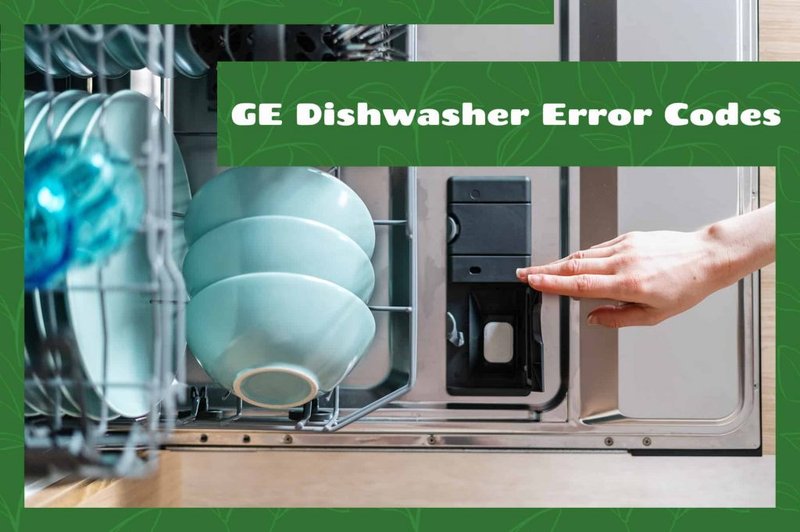
You’ve just finished enjoying a delightful meal, and you load the dishwasher to handle the aftermath. You expect it to work its magic, leaving your dishes sparkling clean. But, wait! Instead of embarking on a cleaning spree, your GE dishwasher greets you with an unfamiliar “OE” error code. If you’ve stumbled upon this code and are scratching your head, wondering what it means, don’t worry. You’re not alone, and this article is here to help you make sense of it.
In essence, the OE error code is your dishwasher’s way of telling you that there’s an issue with the drainage. Think of your dishwasher like a small, efficient cleaning wizard. It needs to dispose of dirty water to continue its cycle. If it can’t do that, it’s like trying to run a marathon with a rock in your shoe—something’s gotta give! This error code is a helpful alert that something is blocking the drainage process. Let’s delve deeper into what could be causing this blockage and how you can address it.
Understanding the OE Error Code
The “OE” error code stands for “Overflow Error” in GE dishwashers. It may sound intense, but it’s essentially the machine’s way of saying it’s having issues getting rid of excess water. You might be thinking, “Is my kitchen about to be flooded?” Not quite. This code is a precautionary measure, ensuring the dishwasher doesn’t function under less-than-ideal conditions that could lead to a bigger mess.
What causes this error? Well, your dishwasher has a drainage system that includes pumps and hoses that transport water out. If there’s a kinked hose, a clogged filter, or debris stuck somewhere in the drainage system, the water simply can’t exit the machine. Imagine trying to blow air through a straw that’s pinched; the air just can’t flow as it should. Similarly, the water in your dishwasher struggles to drain, prompting the OE code.
Fear not, as this code is more of a call to action than a dire warning. It’s a gentle nudge to inspect the drainage components and solve the problem before it escalates. If you address the issue promptly, you can restore your dishwasher’s functionality and prevent future occurrences.
Common Causes of the OE Error Code
Several things can lead to the notorious OE code, but let’s break it down into manageable bits. A key suspect often lies in a clogged or obstructed drain hose. Picture a garden hose; if something blocks it, water can’t escape. Similarly, your dishwasher hose needs a clear path to let water out. An obstruction in this hose could trigger the error code.
Another potential cause is a clogged filter. Dishwashers have filters to trap food particles and debris. Over time, these filters can become clogged, especially if not cleaned regularly. Imagine a strainer—if too much food accumulates, it doesn’t work as efficiently, and water doesn’t pass through as easily. The same applies here, where a buildup in the filter slows down the drainage process.
The problem might also stem from the dishwasher pump. The pump is responsible for moving water out, and if it fails or is obstructed, the water remains. It’s akin to trying to scoop water out of a bucket with a broken ladle; the process just doesn’t work. If you suspect pump trouble, it might be time to get professional guidance or a repair service involved.
How to Fix the OE Error Code
Now that you know the likely culprits, let’s talk solutions. If your drain hose is blocked, carefully inspect and remove any kinks or debris. Disconnect the hose from the dishwasher, check for clogs, and clear them out. This might take a bit of time, but patience is key. Ensuring that water can flow without hindrance is crucial.
If the filter is the problem, removing and cleaning it can do wonders. Locate the filter at the bottom of your dishwasher, usually beneath the spray arms. Gently remove it and wash away any accumulated gunk under running water. Picture it as giving the filter a refreshing shower—it’ll thank you with better performance.
For pump-related issues, while you might be tempted to DIY everything, sometimes it’s best to call in the experts. If you suspect pump failure or blockage, professional technicians can offer targeted solutions and replace faulty parts if necessary. It’s like getting a coach for a sports team—the right person can enhance performance beyond what you could manage alone.
Preventing Future OE Error Codes
Want to avoid the OE hiccup in the future? Regular maintenance can be your new best friend. Just like you wouldn’t go without changing your car’s oil, keeping your dishwasher’s components in check can prevent unexpected issues. Periodically check and clean your dishwasher’s filter. It’s a quick task that can save you a lot of hassle down the line.
Also, be mindful of what you put in your dishwasher. Scrape off excess food from plates before loading them. While dishwashers are designed to handle mess, large chunks of food can lead to blockages over time. Think of it as avoiding a traffic jam; a little pre-planning can keep things moving smoothly.
Lastly, run a maintenance cycle with a dishwasher cleaner every few months. This helps break down any residual buildup and keeps hoses and pumps pristine. It’s akin to giving your dishwasher a spa day, ensuring it functions at its best.
By staying proactive, you can minimize disruptions and ensure your GE dishwasher serves you well for years to come. So, when that OE code pops up, remember you’ve got this. With a little know-how and regular care, you can tackle and prevent this error with ease.